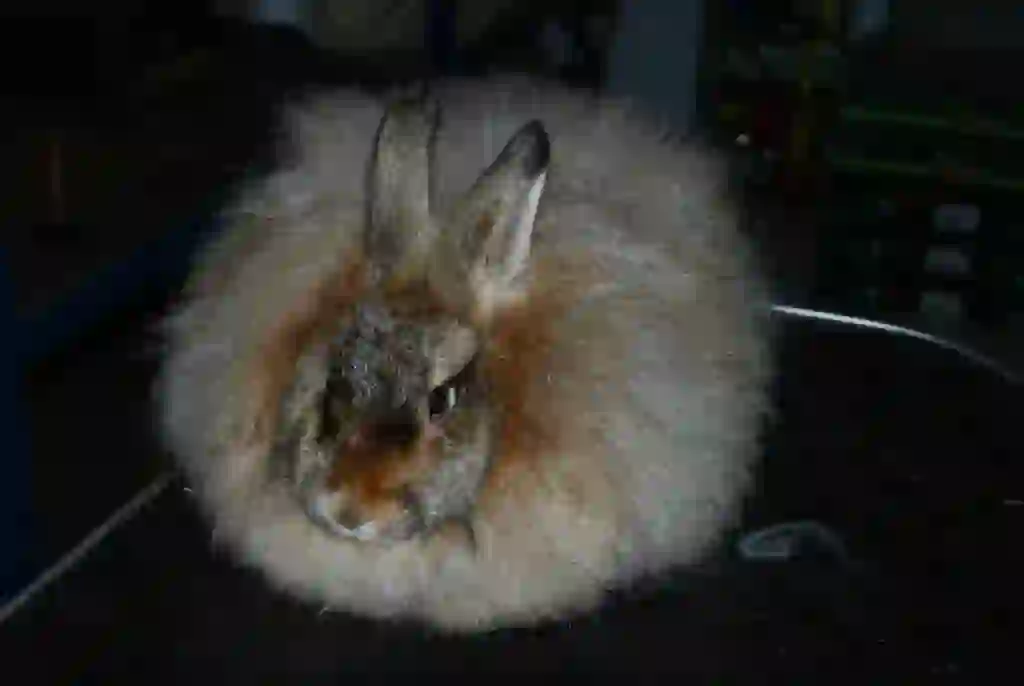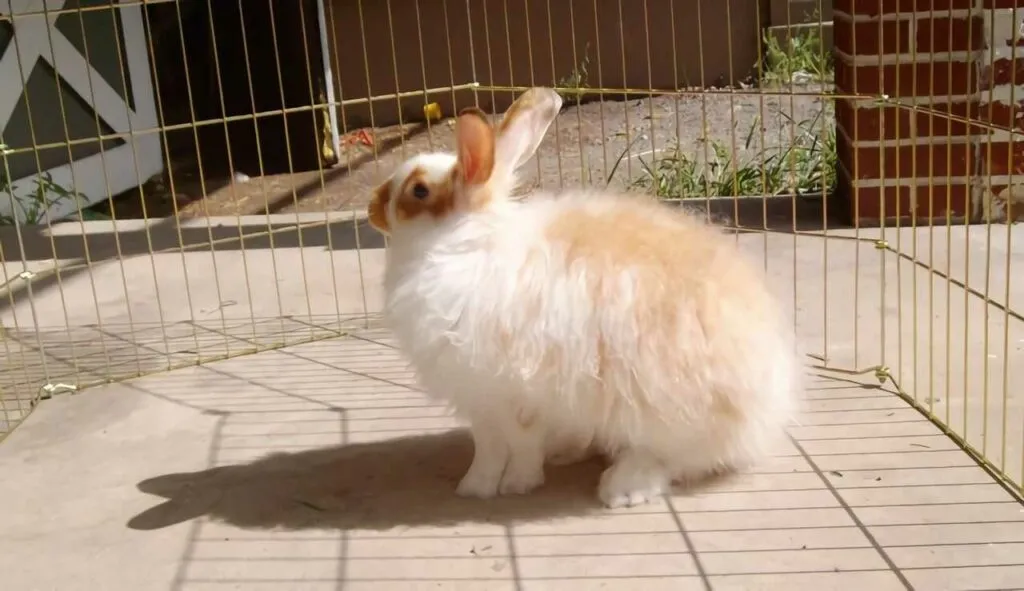
Satin Angora
Satin Angora
Satin Angora
Have you ever heard of a rabbit called “Satin Angora”? Honestly, it’s not often seen in Japan, so many people may be hearing about it for the first time! To briefly explain, it looks very similar to French Angora with its fluffy, ball-like body and cute face peeking out. However, it actually has some different characteristics from French Angora. So where is the difference? Let’s go find out the secret right away!
Satin Angora Basic Infomation

Country of origin Canada.
Senior / Both males and females are 2.95kg~34.31kg for more than 6 months, and the ideal weight is 3.63kg.
Junior / Both males and females are less than 6 months old Less than 2.49 kg Minimum weight 1.25 kg.
Junior / female Less than 6 months Less than 2.95 kg Minimum weight 1.47 kg. ※American Rabbit Breeders Association(ARBA)standards.
It is said that L. Peopoldina Meyer received a long-haired rabbit born from a mutation, which led to the birth of Satin Angora.
Meyer wanted to create rabbits with even longer fur, so she tried crossing “fawn-colored French Angora” with “copper-colored Satin.” As expected, a rabbit with longer fur than the one she received was born.
When she continued to crossbreed them, one day a rabbit with a deep red hue was born. Meyer decided to continue improving the breed, thinking that she wanted to create rabbits with even more beautiful fur and establish them as a breed. The rabbits born thereafter were named Satin Angora in 1987 and officially registered as a breed.
Satin Angora Q&A

Where does Satin Angora get its name?
When Angora rabbits were first discovered, they were named after the place where they were found, “Ankara” in Turkey. However, in the early 18th century, it was called “Angora.” Meyer improved the breed of this rabbit and named it “Satin Angora.”
By the way, satin means “a glossy fabric or textile,” which is a perfect name for Satin Angora, which has shiny fur.

What are the color variations of Satin Angora?
・Self (the entire color is almost monochrome). Black, blue, chocolate, lilac, blue-eyed white, ruby-eyed white.
・Shaded (the color of the ears, nose, tail, and feet is dark and gradated). Sable, smoke pearl, pearl, seal, blue tortoiseshell, chocolate tortoiseshell, lilac tortoiseshell, tortoiseshell.
・Agouti (one hair is divided into three or more colors). Lilac chinchilla, chocolate chinchilla, chinchilla, squirrel, chestnut, chocolate agouti, copper, lynx, opal.
・Pointed white (white body with points). Black, blue, chocolate, lilac.
・Ticked (different hair colors are mixed on the body). Steel blue, steel lilac, steel chocolate, steel.
・Wideband (hair from head to foot is the same color and different from hair around the eyes and belly). Cream, fawn, red.
There are brown, blue-gray, ruby red and blue.
Satin Angora is only a long-haired breed.

What does a Satin Angora look like?
Satin Angora rabbits have an oval-shaped head and round eyes. They have a commercial body type with good meat quality. Beautiful fur grows almost all over their body, and they have a little decorative fur on their face. Compared to other Angora breeds, Satin Angora has a rich luster in its coat color, which is due to the fact that its hair is finer, softer, and more reflective than other rabbits.
To maintain this beautiful appearance while preventing illness, daily brushing is necessary for Satin Angora. It is recommended to use a slicker brush or comb to untangle the fur and blow away dust and debris with a blower.
By the way, as I mentioned in the basic information, this shed fur can be spun into Angora wool. Scarves and small items made from the shed fur of your beloved pet rabbit are sure to become your favorite items!

What is the difference between Satin Angora and French Angora?
These two breeds are so similar that it is said to be difficult to distinguish them at first sight. Both breeds weigh around 4 kg, and the length of their fur is almost the same, with Satin Angora’s fur being slightly shorter.
Although it is difficult to judge by appearance, the decisive difference is that Satin Angora’s hair has a “semi-transparent structure due to a mutation.” It is still not clear why only Satin Angora underwent this mutation. However, as research progresses, the day may come when this mystery is solved!

How much does it take to buy a Satin Angora?
When keeping animals, it is necessary to follow the laws established by each country. This time, I will talk about keeping Satin Angora at home in Japan. It costs about 100,000 yen. The circulation of Satin Angora is low, so the price is slightly higher than other rabbits.
Also, rabbits that have the potential to win at rabbit shows are called “show types,” and rabbits that are suitable for keeping at home without any problems are called “pet types.” However, if you want to keep a show type Satin Angora at home, it may be a little more expensive.

I want to know more about the character of Satin Angora!
Satin Angora rabbits are generally calm and gentle, so they don’t mind being petted or held. However, their personality may vary depending on the individual, so it may be better not to lift them up if they show signs of discomfort.
They prefer to spend their time at their own pace and relax rather than engage in active movements such as running, jumping, or hopping.
※When keeping animals, it is necessary to follow the laws established by each country.

What are the diseases that Satin Angora is susceptible to?
Satin Angora rabbits are susceptible to diseases such as “Rabbit Gastrointestinal Syndrome (RGIS),” “malocclusion,” and “heatstroke.”
It used to be called “hairball disease.” Rabbits may accidentally swallow loose hair after grooming. If the swallowed hair comes out with feces, there is no problem. However, if a large amount of hair clogs the digestive tract, it can cause loss of appetite and constipation.
At that time, it was called hairball disease because the cause was thought to be hair. However, recent research has shown that clogging of the digestive tract is not caused by hair alone, so it has been collectively called Rabbit Gastrointestinal Syndrome for easy understanding.
Since this disease is said to be possible in almost all rabbits, prevention methods include feeding them fibrous timothy hay, exercising them, giving them enough water to prevent dehydration, and brushing them moderately by their owners.
Since rabbits’ teeth continue to grow throughout their lives, they can usually prevent excessive growth by eating chew toys or fiber-rich food. However, if their teeth are not properly trimmed for some reason, their bite may become misaligned.
If their teeth are in poor condition, they may lose their appetite or develop diseases such as nasolacrimal duct stenosis. Therefore, if you have any concerns about your rabbit’s teeth or eating habits, it is recommended that you consult an animal hospital.
Heatstroke is something that we humans can also get, so many of you may be familiar with it. Satin Angora rabbits have a strong resistance to cold but are weak to heat. Especially in recent years, Japan has had many extremely hot days, so it is essential to use air conditioning appropriately.
When using air conditioning, set the room temperature to 20 degrees Celsius. One way to adjust the amount of fur is to get a summer cut. Also, even on days when it is not summer but the temperature is high, it is recommended to use air conditioning actively and adjust the indoor environment.

What is the lifespan of a Satin Angora?
The average lifespan of a rabbit is said to be around 6-10 years, which is about the same as the average lifespan of a typical rabbit.

Would you like to become a part of the 'Animalbook.jp'?
Turn your knowledge into Q&A and share it with the world. ※Publication will be activated after purchase. Let's share information together!
Satin Angora Type of List

- Satin Angora
Information
Congratulations! You are the first commenter!

Create Your Favorite List!
Satin Angora
Save the animals you love! Build your own list to quickly revisit your favorites later.

Would you like to leave a comment?
※Please note: This is for the purchase of rights to post comments within the article.
Find Your Favorites!
Our shop offers a unique and attractive selection of goods themed around various animals.
Satin Angora References
Satin Angora Introduction of media used

出典:https://commons.wikimedia.org/wiki/File:Satinangora.jpg

other
出典:https://commons.wikimedia.org/wiki/File:Satinangora_rot_Garn_und_Flocke.jpg

出典:https://commons.wikimedia.org/wiki/File:Satin_Angora.JPG

Help Enrich Our Animalbook.jp with Your Media!
We are constantly looking to expand and enrich our Animalbook.jp with amazing photos and videos of animals. If you have any media that you'd like to share, please contribute and help us showcase the beauty and diversity of the animal kingdom. Your submissions will be credited and featured in our encyclopedia, reaching a wide audience of animal lovers.


















